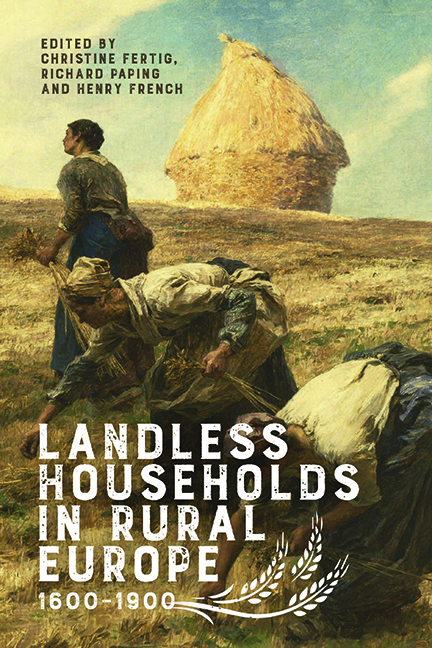Book contents
- Frontmatter
- Contents
- List of Illustrations
- Notes on Contributors
- Preface
- Introduction
- 1 The Treballadors of Girona: Evidence of the Emergence of Wage Labour in Early Modern Catalonia in the Sixteenth and Seventeenth Centuries
- 2 The Squatter Economy of the English Countryside: Building New Landless Communities in England, c. 1600–1900
- 3 The Rise of Landless Households in the Dutch Countryside, c. 1600–1900
- 4 ‘Gaining Ground’ in Flanders after the 1840s: Access to Land and the Coping Mechanisms of Landless and Semi-Landless Households, c. 1850–1900
- 5 Strategies of Survival, Landlessness and Forest Settlement in Flanders: The Forest of Houthulst in a Changing Landscape of Survival (c. 1500–1900)
- 6 Landless and Pauper Households in England, c. 1760–1835: A Comparison of Two Southern English Rural Communities
- 7 Landless Rural Households in France, 1852–1910
- 8 Survival in a Hostile Agrarian Regime: Landless and Semi-Landless Households in Seventeenth-Century Sweden and Finland
- 9 Farming Craftsmen? Access to Land and the Socio-Economic Position of Rural Artisans in Early Modern Finland
- 10 Landlessness and Marriage Restrictions: Tyrol and Vorarlberg in the Eighteenth and Nineteenth Centuries
- 11 Cottages, Barns and Bake Houses: Landless Rural Households in North-Western Germany in the Eighteenth Century
- Bibliography
- Index
- Boydell Studies in Rural History
2 - The Squatter Economy of the English Countryside: Building New Landless Communities in England, c. 1600–1900
Published online by Cambridge University Press: 08 October 2022
- Frontmatter
- Contents
- List of Illustrations
- Notes on Contributors
- Preface
- Introduction
- 1 The Treballadors of Girona: Evidence of the Emergence of Wage Labour in Early Modern Catalonia in the Sixteenth and Seventeenth Centuries
- 2 The Squatter Economy of the English Countryside: Building New Landless Communities in England, c. 1600–1900
- 3 The Rise of Landless Households in the Dutch Countryside, c. 1600–1900
- 4 ‘Gaining Ground’ in Flanders after the 1840s: Access to Land and the Coping Mechanisms of Landless and Semi-Landless Households, c. 1850–1900
- 5 Strategies of Survival, Landlessness and Forest Settlement in Flanders: The Forest of Houthulst in a Changing Landscape of Survival (c. 1500–1900)
- 6 Landless and Pauper Households in England, c. 1760–1835: A Comparison of Two Southern English Rural Communities
- 7 Landless Rural Households in France, 1852–1910
- 8 Survival in a Hostile Agrarian Regime: Landless and Semi-Landless Households in Seventeenth-Century Sweden and Finland
- 9 Farming Craftsmen? Access to Land and the Socio-Economic Position of Rural Artisans in Early Modern Finland
- 10 Landlessness and Marriage Restrictions: Tyrol and Vorarlberg in the Eighteenth and Nineteenth Centuries
- 11 Cottages, Barns and Bake Houses: Landless Rural Households in North-Western Germany in the Eighteenth Century
- Bibliography
- Index
- Boydell Studies in Rural History
Summary
Landless rural families existed widely in England as across Europe since medieval times, but recent research on long-term growth and changes in male occupational structure suggests that in England the landless proportion of the population was significantly higher than in most neighbouring European countries by 1800, and almost certainly by the late seventeenth century.
The proportion of the population working in English agriculture was about 70 per cent in 1500 and fell to less than 40 per cent by 1800. As English urbanisation started from a low point in 1500 when less than 10 per cent of the population lived in towns, with no more than 30 per cent in 1800, the scale of rural landlessness was probably significantly higher than in Europe generally. This chapter analyses the nature and scale of landlessness in early modern England, first by discussing its relationship to urban growth, to changes in occupational structure and to the family economy of the landless rural household; and subsequently by focusing on where, how and why numbers of rural landless families were rising.
Defining landlessness in an English context is complex. A definition based on ownership criteria – not holding land on any form of tenure (be it freehold, copyhold or long-leasehold) that had lifetime security for an individual and their heirs – would exclude a substantial proportion of farming families, since by 1700, and even more by 1800, many farms were held on year-to-year tenancies, or on leases of up to twenty-one years, or as sub-tenancies of copyholders. On this definition, some ‘landless’ families could farm on a substantial scale. Many prosperous farmers working leased land invested their savings in small landed estates or cottage property both as a secure way of holding wealth and as a point of entry into political participation both locally and nationally. The ownership criterion is also complicated by urban dwellers making widespread investment in rural land and housing in the period before 1750. Henry French and Richard Hoyle have identified and quantified this in their detailed case study of Earls Colne (Essex). This chapter will therefore use lack of regular working access to defined areas of land (i.e., not common land) as the criterion for landlessness.
- Type
- Chapter
- Information
- Landless Households in Rural Europe, 1600-1900 , pp. 37 - 62Publisher: Boydell & BrewerPrint publication year: 2022

